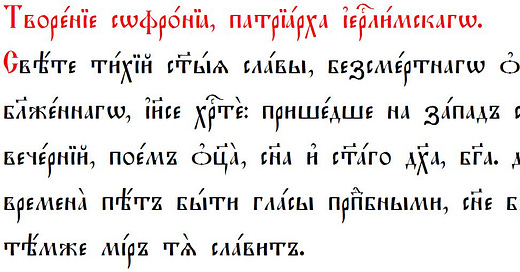Music is found in every culture around the world and has existed for at least 55,000 years.
Although musical compositions may have existed this far back in human history, the earliest written songs only date back to over 3,000 years ago.
Special Edition:
Phos Hilaron is an ancient Christian hymn originally written in Koine Greek.
Often referred to in the Western Church by its Latin title Lumen Hilare, it has been translated into English as O Gladsome Light.
It is one of some of the earliest known Christian hymns recorded outside of the Bible that is still in use today.
The hymn is part of vespers in the Byzantine Rite and the Catholic Church, and also included in some Anglican and Lutheran liturgies.
The hymn was first recorded by an unknown author in the Apostolic Constitutions, which was written in the late 3rd or early 4th century.
It is found in a collection of songs to be sung in the morning, in the evening, before meals, and at candle lighting.
Phos Hilaron is to be sung at the lighting of lamps in the evening and so is sometimes known as the “Lamp-lighting Hymn”.
Despite some of the words to the other three songs being from Scripture or in one case dated to around 150, Phos Hilaron is the first to be considered an actual hymn in the modern sense.
It is certainly the first complete example.
It is far more rhythmic than the others and is divided into twelve verses varying between five, six, eight, nine, ten and eleven syllables a verse.
Basil of Caesarea (329–379) spoke of the singing of the Phos Hilaron as a cherished tradition of the church, the hymn being already considered old in his day (though some attribute the composition of the song to Basil himself).
The original melody, as used by the Greek Orthodox Church in the original text, is considered taxing on the voice as it spans almost two octaves, with the voice peaking on the words “Heavenly” and “the Father”.
At that time in Jerusalem, a lamp was kept perpetually burning in the empty tomb of Christ, its glow a symbol of the living light of Jesus.
As Christians gathered to worship the hymn was sung and, in a tradition known as the lighting of the lamps, a candle lit from the lamp was brought forth from the tomb, its bright, solitary flame calling the church to celebrate the Risen Lord.
Saint Athenogenes, a saint of unknown date but whose saint's day is July 16, is believed by some (including Basil) to have composed this hymn on the way to being martyred.
He is often depicted as an elderly bishop with the executioner's arm paralyzed until the saint has completed his song.
The Roman Martyrology states:
“In Pontus, the birthday of Saint Athenogenes, is celebrated.
He was an aged theologian, who, when about to consummate his martyrdom by fire, sang a hymn of joy, which he left in writing to his disciples.”
He is probably identical to the bishop who was martyred with ten disciples in Sebaste, Armenia, on July 16 during the reign of Emperor Diocletian, most probably c. A.D. 305.
Sophronius of Jerusalem (560− 638), who was known for his poetry, is believed to have revised the hymn and Orthodox liturgical books often identify him as the author, e.g., in the Slavonic text above.

















Share this post